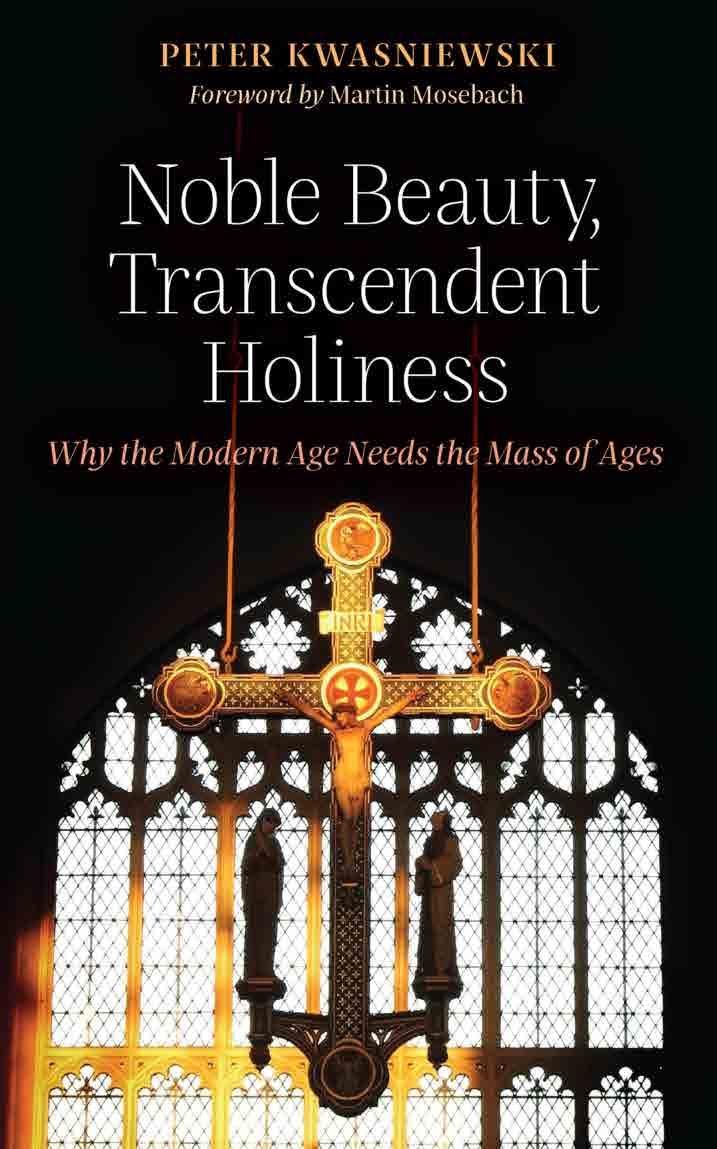
4 minute read
Noble Beauty, Transcendent Holiness: Why the Modern Age Needs the Mass of Ages, by Peter Kwasniewski
Foreword by Martin Mosebach. (Angelico Press, 2017)
By Joseph Shaw
Dr Peter Kwasniewski is a musician as well as an academic philosopher and theologian, and his work, exemplified in this book and in his prodigious blogging output, provides a link between fundamental principles of theology and philosophy and the practical, pastoral issues with which Catholic musicians, like priests engaged in pastoral work, have to grapple. Does this or that engage people? Can it be done with limited resources? Can it be part of a growing Church, drawing people in, inspiring commitment, supporting families, and fostering vocations?
Kwasniewski’s experience, like the experience of many, is that the Church’s liturgical tradition works. The paradox of the debate about ‘progressive’ versus ‘traditional’ liturgy over the last century has been that, while progressive liturgists brush aside the Church’s perennial wisdom about liturgy, and above all the ultimate purpose of liturgy, the worship of God, in favour of something designed for pastoral effectiveness, the end product is something which is not very pastorally effective.
To put it at its mildest, it is difficult to discern the positive effect the reformed liturgy has had in the context of the collapse of all aspects of Church life since the 1960s.
To the argument that Gregorian Chant, beautifully decorated churches, and above all the Traditional Mass, actually bring people into church, on the other hand, progressive liturgists tend to respond with purely theoretical arguments.
People may like chant and Latin, they say, but they shouldn’t, because they encourage the wrong kind of liturgical participation. The vocations of young men and women may be nurtured by that kind of liturgy, but they are the wrong kinds of vocations. Worshippers may feel consoled and strengthened, but either this is fake, or it is bad.

In this eloquent and wide-ranging book Kwasniewski does a service to his readers and to the Church by addressing both sides of the issue: the practical, pastoral, and psychological, on the one hand, and the theoretical and theological on the other.
The restoration of Tradition will not be possible unless it is made clear that the revival found in centres for the Traditional Mass—the conversions, the young families, the vocations—is based on something genuine.
Fake or misguided religiosity is certainly possible. It might be the sense of belonging and mission found in a cult, or the euphoria of group hysteria. I won’t rehearse the insults and insinuations about Traditional Catholics made by progressives: what is important is the truth of the matter.
What Kwasniewski does in this collection of essays is to connect the real pastoral value of the ancient liturgy with objective theological principles.
A good place to start is with Narcissism—self love. Kwasniewski quotes Pope Benedict (writing before his election) writing about the danger of the liturgy becoming a ‘feast the community gives itself’ (p15), which allows the worshippers, ultimately, to worship not the God outside themselves, but simply themselves. How can this be avoided?
By a liturgy which is not a human creation at all, but something which is given to us from the Tradition of the Church, the instrument of Providence. Whose texts and readings have not been chosen by people of our generation, or any recent generation. Which keeps reminding us that it we are not important: we are not being addressed, it is not even in a language we necessarily understand, it is not even necessarily aloud or visible. Rather, it is addressed to God.
In this way the Traditional Mass guards against a pervasive temptation, not just through its words, but by its whole atmosphere and approach. Progressives might protest that the aspects of the old Mass I have just mentioned are those which cut people off from it, which makes it alien. However, those attracted by it, those able to see the point of it, perceive in this apparent indifference to the congregation an indication of its God-centredness, and it is a God-centred liturgy which they want.
If we seek the Kingdom of God, then these other things will be added also: an experience of participation, of interior consolation, and indeed of community. By seeking those good results at the expense of the worship of God, the danger arises of getting neither.
This liturgy, with its mystery and beauty, takes us out of ourselves. It places us in the heavenly court, before God’s throne, where we may place our petitions for our daily lives, for the good of the Church and for the Holy Souls, but most of all where we can simply be close to Him, not empty handed or alone but in union with Christ, and to feel His influence. The God-given and God-facing liturgy is the Church’s tool to make the people God-like.
Noble Beauty, Transcendent Holiness is available from the LMS on-line shop £16 + p&p.










